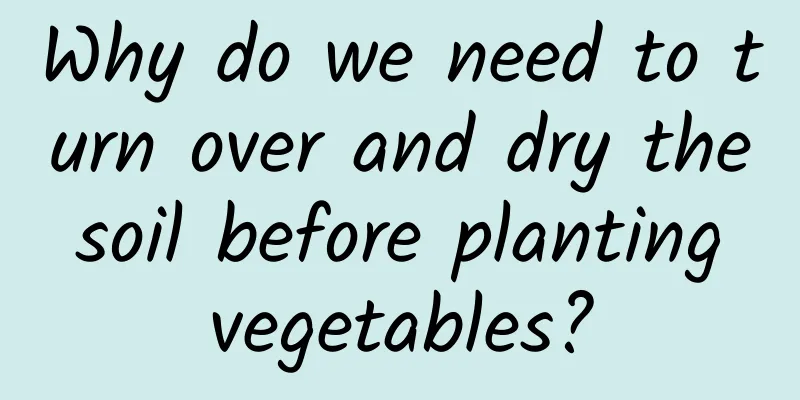Why do we need to turn over and dry the soil before planting vegetables?

|
Whether it is vegetable planting, fruit tree planting or grain crop planting, the soil needs to be deep plowed before planting, which is what we often call turning the soil. Why do we do this? Why do we need to till the soil before planting vegetables?Because deep plowing of the soil has several good effects, it can improve crop growth efficiency and reduce the occurrence of diseases. Specifically, deep plowing of the soil has the following main effects. First, deep tillage can loosen the soil.The soil we are familiar with is thick and hard. Such soil has dense porosity and poor permeability. If sowing and planting are carried out directly, the roots will not be easy to take root and water and fertilizer will not penetrate well. After deep plowing, the soil becomes loose, which is more conducive to the growth of crops. Not only is it easier for the roots to take root, the soil's ability to retain water and air is also improved, and the soil's aeration is also improved, which is beneficial to the sowing and development of crops. Secondly, deep tillage can reduce the occurrence of diseasesThe most feared thing in vegetable planting is soil-borne diseases. After a year's planting, many pathogens and insect eggs remain deep in the soil. If deep plowing is not done, the pathogens will continue to multiply in the soil, which will inevitably affect the growth of crops in the next year. Deep plowing can turn up the deep soil, and exposure to sunlight can kill the bacteria and insect eggs in it. Combined with the use of pesticides, root irrigation and other methods, soil-borne diseases can be prevented from occurring the following year. Third, deep tillage can improve soil fertilityMany people believe that the nutrients for crop growth depend on fertilizers. In fact, the nutrients in the soil also have a great impact on crop growth, and most of the nutrients for crop growth come from the soil. Deep plowing can bury green manure, crop residues and organic fertilizer applied on the topsoil layer into the lower layer, creating favorable conditions for the survival, reproduction and activity of microorganisms and accelerating the process of soil maturation. Through the decomposition and transformation of soil microorganisms, the fertilizer efficiency of organic fertilizer will be improved and the soil condition will be improved. Fourth, deep tillage can restore soil structure.The soil that has been cultivated for many years has been damaged to a great extent. These soils may become compacted and salinized. Through deep plowing, the upper layer of soil with poor structure can be turned to the lower layer. These soils are gradually restored in the deep soil layer and are turned to the upper soil layer during deep plowing the following year. This cycle is repeated, which protects the soil and also restores the soil structure. Therefore, there are many benefits to deep soil plowing, but we must also pay attention to the time and depth of deep plowing. The best time for deep plowing is generally after the crops are harvested. At this time, the stubble on the ground can be turned into deep soil and become fertilizer after rotting. The depth of deep plowing should be adapted to local conditions. For example, deep plowing in arid areas should be shallower, while deep plowing in saline-alkali land should be relatively deeper. |
>>: How to plant leek seeds and get good germination results (leek seed planting method and steps)
Recommend
How to make plum trees bear more fruit?
Everyone should be familiar with plums. They belo...
Rubber tree cutting method and precautions What season is the best cutting effect
The leaves of the rubber tree are huge and dark i...
How to grow sedge
1. Breeding environment 1. Soil: Loose and well-b...
Cultivation methods and precautions of Gaillardia
How to grow Gaillardia Light and temperature Gail...
How to divide the pots when the green radish is too dense
1. Prepare materials To divide the pot for the gr...
How to plant irises and how to care for them later
1. How to plant 1. Planting time: You need to cho...
Can Astragalus and American ginseng be soaked in water together? What are the effects of soaking in water?
1. Can we drink water together? Astragalus and Am...
The advantages and disadvantages of soft fragrant red rose
Soft and fragrant red rose is a purebred rose pro...
Keeping the fairy finger at home can help you sleep and is easy to maintain, simple and worry-free
1. Is it suitable for indoor growth? Is the fairy...
How to grow Rouge Cloud succulent
1. Cultivation soil When planting Rouge Cloud suc...
When and how to change the soil of banyan trees
Banyan tree soil replacement time It is best to c...
How to prune lucky bamboo
1. Trimming leaves If the tips of lucky bamboo le...
How to prune the maidenhair fern
Why should we prune the maidenhair fern? When gro...
How to grow cactus
1. Breeding environment 1. Soil: Cactus is a dese...
When and how to change the soil for blueberries
Blueberry soil change time Blueberries are usuall...









